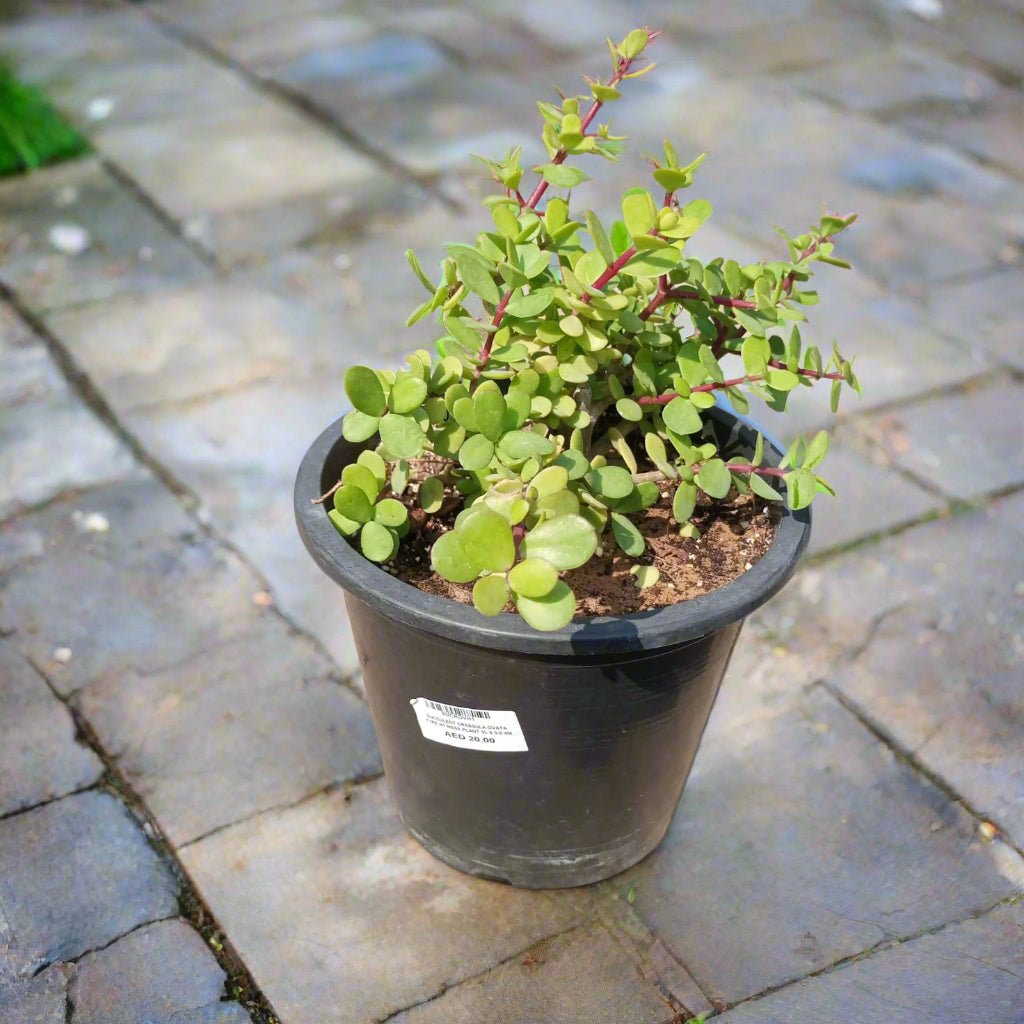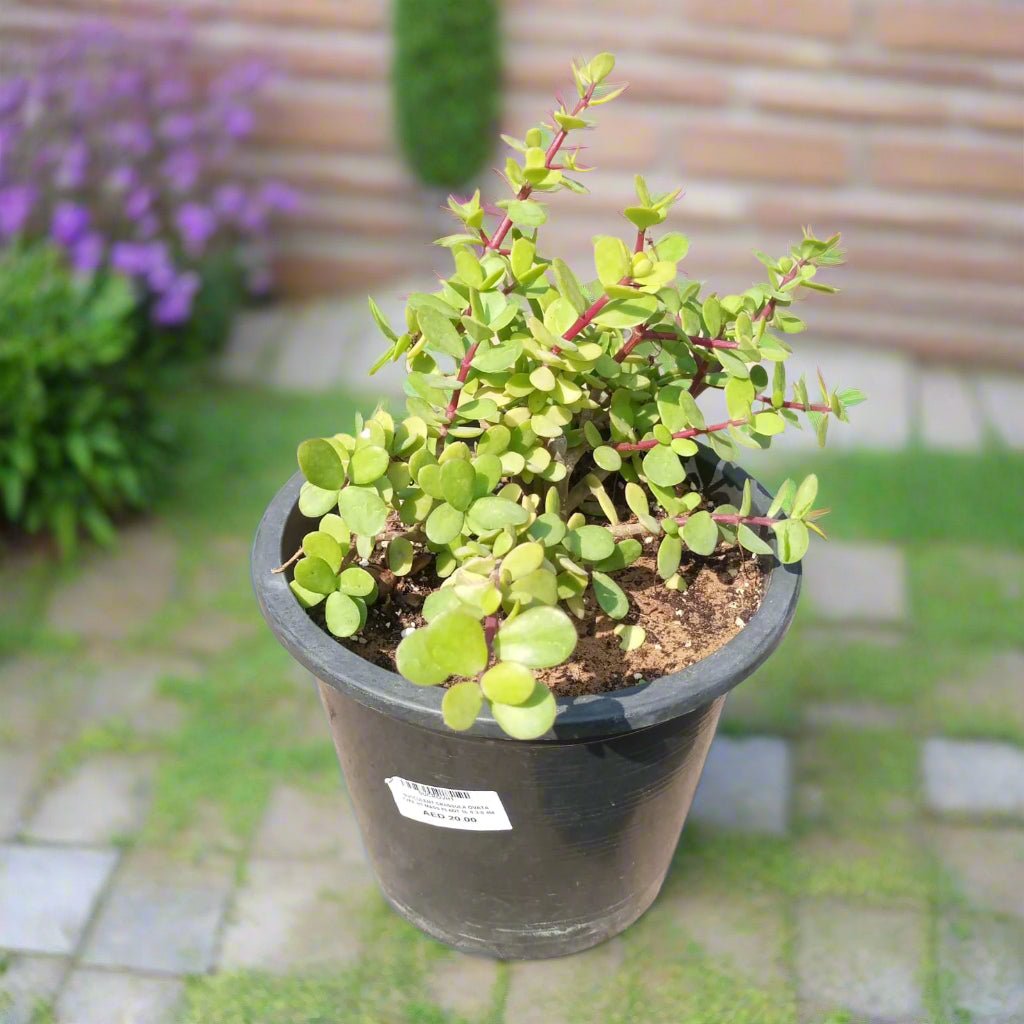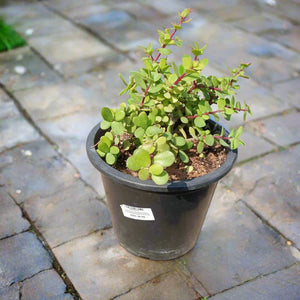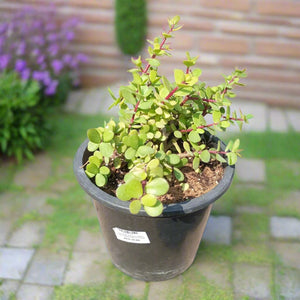Succulent Crassula Ovata | 20 - 30cm
Guarantee Safe Checkout
Website Exclusive - Free Delivery in Dubai & Sharjah
Free replacement if you receive a defective item during delivery

Succulent Crassula Ovata | 20 - 30cm
Succulent Crassula Ovata Type H1 Mass plant 5LP, 20-30CM
Crassula ovata 'Mass Plant', also known as the Jade Plant or Lucky Plant, is a cultivar of the well-known Crassula ovata species. Crassula ovata is a popular succulent native to South Africa and Mozambique. The 'Mass Plant' variety is characterized by its compact, bushy growth habit, with tightly packed, thick, fleshy leaves that store water, making it highly drought-tolerant.
Here are key details about Crassula ovata 'Mass Plant':
1. Appearance:
Size: This cultivar tends to be more compact and bushy compared to the standard Jade plant. It typically grows to about 1–2 feet (30–60 cm) in height and width, making it ideal for smaller spaces or container gardening.
Leaves: The thick, glossy leaves are round to oval-shaped and have a vibrant green color. Some varieties may develop a reddish edge or tint when exposed to more sunlight, which is a characteristic feature of the 'Mass Plant' cultivar.
Stems: The plant has woody stems that become thicker as it matures. These stems are usually grayish-brown and can develop a tree-like appearance in older plants.
Flowers: Crassula ovata 'Mass Plant' produces small, star-shaped white or pale pink flowers, typically in late winter or early spring. The flowers are not as showy as the foliage but can add to the plant’s charm.
2. Soil: Like most succulents, Crassula ovata 'Mass Plant' needs well-draining soil. A cactus or succulent mix is ideal, or you can add sand or perlite to regular potting soil to increase drainage.
Watering: As a succulent, it is highly drought-tolerant and does not need frequent watering. Water the plant thoroughly when the soil is completely dry, but be sure to allow excess water to drain away to prevent root rot. During the winter months, the plant requires even less water.
3. Temperature: Jade plants prefer warm temperatures between 60–85°F (15–29°C). They should be kept away from cold drafts and freezing temperatures, as they are not frost-tolerant.
4. Maintenance:
Pruning: Crassula ovata 'Mass Plant' benefits from occasional pruning to maintain its compact shape and remove any dead or leggy stems. You can also prune to propagate new plants. Pruning is best done in the spring or summer when the plant is actively growing.
Fertilizing: Fertilize the plant lightly during the growing season (spring and summer) with a diluted, balanced fertilizer or a fertilizer specifically designed for succulents. Avoid fertilizing in the fall and winter when the plant is dormant.
Repotting: Jade plants grow slowly, so they don't require frequent repotting. However, when the plant outgrows its container or if the soil has degraded, repotting every 2–3 years is a good idea. Choose a pot with drainage holes to avoid water retention.
5. Propagation:
Stem Cuttings: Crassula ovata 'Mass Plant' can be easily propagated from stem cuttings. To propagate, cut a healthy stem and allow it to callus over for a few days in a dry, shaded area. Once the cut end has callused, plant it in well-draining soil. Water lightly until roots establish.
Leaf Cuttings: Leaf cuttings can also be used for propagation, though stem cuttings tend to root more easily. Place a healthy leaf in well-draining soil and allow it to root, though this method can take longer.
6. Common Problems:
Overwatering: One of the most common issues with jade plants is overwatering, which can lead to root rot. Make sure the plant is in well-draining soil, and always allow the soil to dry completely between waterings.
Leggy Growth: If your plant becomes leggy, it might be a sign of insufficient light. Move it to a brighter spot to encourage fuller growth.
Pests: While jade plants are generally resistant to pests, they can occasionally be affected by mealybugs, aphids, or scale insects. Treat infestations with insecticidal soap or neem oil.
7. Other Characteristics:
Slow Growth: Crassula ovata 'Mass Plant' grows slowly, which makes it a great option for those who prefer low-maintenance plants that don't require frequent repotting.
Toxicity: Like many other plants in the Crassula genus, Crassula ovata is mildly toxic to pets if ingested, especially cats and dogs. The plant's sap can cause mild gastrointestinal issues and should be kept out of reach of animals.



